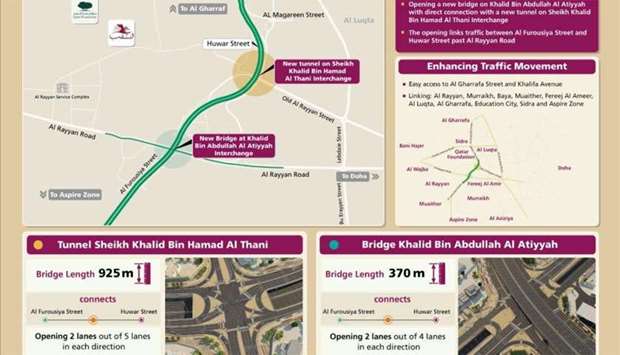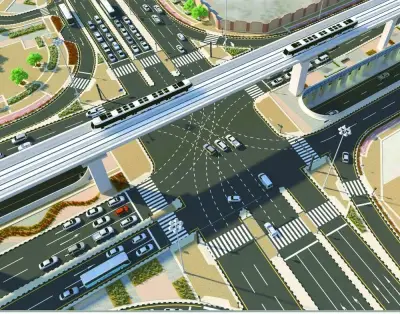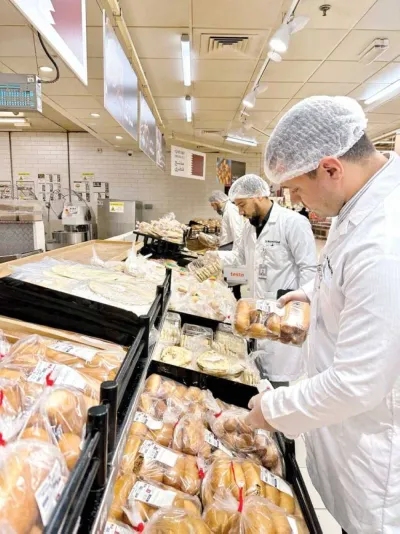Phase two of Al Rayyan Road expansion works will see the development of the road from the west of Olympic Roundabout to the west of Khalid Bin Abdullah Al Attiya Roundabout (New Rayyan Roundabout).
It will see the development of a new dual carriageway of 5.5km in four lanes in each direction besides the development of five main intersections, a bridge and a tunnel.
Part of the expansion is the development of the intersection of Al Rayyan Road with Al Furousiya Street. This intersection will see the construction of roads at three levels so that Al Rayyan Road traffic would flow smoothly through the tunnel while the local traffic uses the signals at the ground level of the intersection.
At the intersection of the Al Rayyan Al Qadeem Street with Al Huwar Street, there would be roads at two levels so that the street traffic will flow freely through the tunnel and the Al Rayyan Al Qadeem Street on the ground level will have a traffic control through new signals.
At the intersection of Al Rayyan Road with Al Bustan Street, there will be roads at three levels ensuring free-flowing traffic on the Al Rayyan Road through the tunnel while the local traffic flow will be at the ground level, to be controlled by signals.
At the intersection of Al Rayyan Al Qadeem Street with Al Bustan Street, there will be roads at two levels which would facilitate free traffic flow on Al Bustan Street through the tunnel. The traffic on the Al Rayyan Al Qadeem Street will be on the ground level and will be co-ordinated by the traffic lights.
At the intersection of Al Rayyan Road and 22nd February Street, there will be roads at four levels. The current intersection is being rebuilt and a new bridge will be constructed with the support of two structures to accommodate traffic coming from the north on 22nd February Street. Traffic coming from the west will be on Al Rayyan Road.
At Al Messila tunnel, a two-level intersection is to be built at the ground level on Al Rayyan Road. It will ensure smooth traffic on Jassim Bin Hamad Street, using the tunnel which connects the eastern side of Al Rayyan Road directly.
A one-way bridge with two corridors is being built at Rayyan bridge area. It would contribute to smooth traffic from Al Waab towards the new Al Rayyan Street, thus relieving pressure on Al Rayyan Roundabout.
The second phase of Al Rayyan Road Construction and Development Project involves the implementation of extensive works to establish and upgrade the infrastructure of the area within the scope of the project, where 31km of treated sewage lines will be installed for irrigation of green spaces and a 40km of stormwater drainage network will be installed. It will also feature a 32 km-drinking water pipeline and the installation of 15km of sewage networks.
It may be recalled that in the second half of 2017 Al Messila Tunnel was opened in addition to the opening of Jassim Bin Hamad Street, which is directly connected to Al Rayyan Road. The street has been widened and expanded and sections of the old Traffic Roundabout which was diverted into an intersection with traffic lights have been opened for traffic.
Al Messila Tunnel, located below Al Rayyan Road, and 800m west of the Olympic Roundabout, is the first construction achievement in the Phase 2 of the Al Rayyan Road Development Project, pointed out Ashghal officials on Saturday.
Ashghal has also opened the one-km long Al Rayyan Interchange and it consists of two lanes in one direction for connecting traffic from Al Amir Street and Doha Expressway with the new Al Rayyan Road.
Ashghal had opened the first phase for the development of Al Rayyan Road at the beginning of 2017. The road extends for about 3km west of Khalid Bin Al Attiya (New Rayyan Roundabout) to the east of Bani Hajer roundabout, and it included the construction of four lanes in each direction separated by a central island, 2km of roads and 5.8km of service roads.
The development also consisted of developing three intersections which are Al Shafi Street, and Al Qalaa Street and Al Wajba Street with Al Rayyan Road.
The project also included pedestrian and cycle paths to encourage the public to walk and use bicycles.



